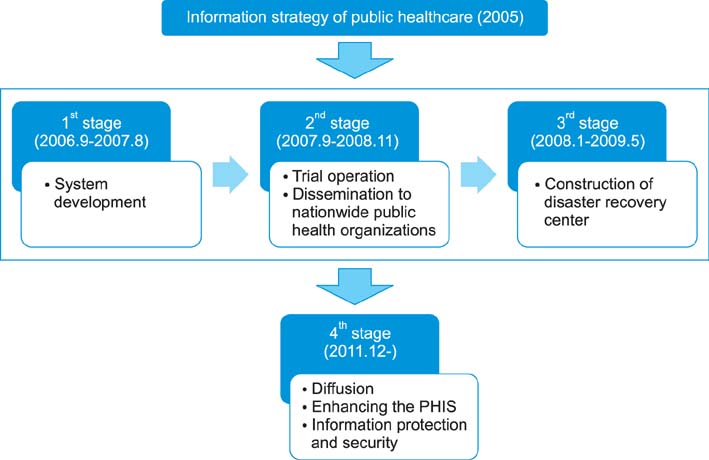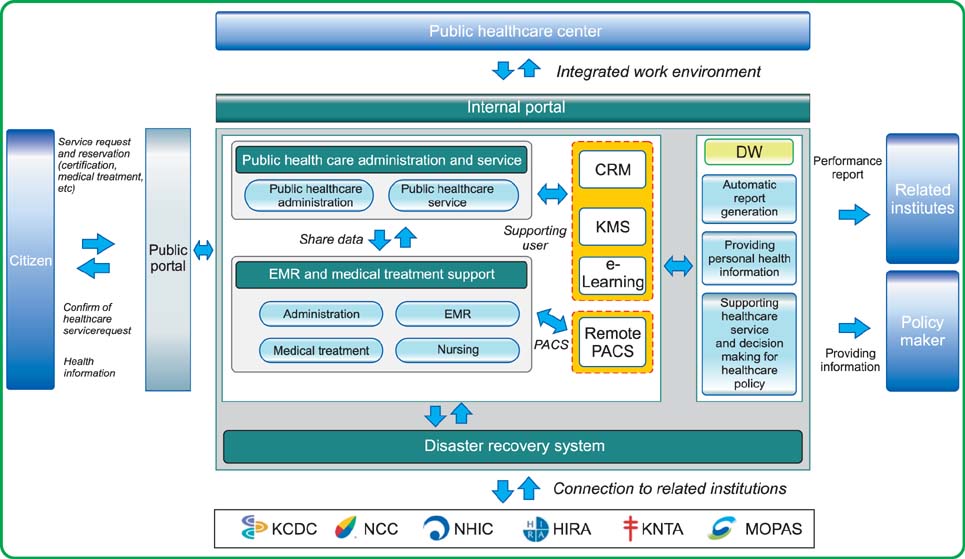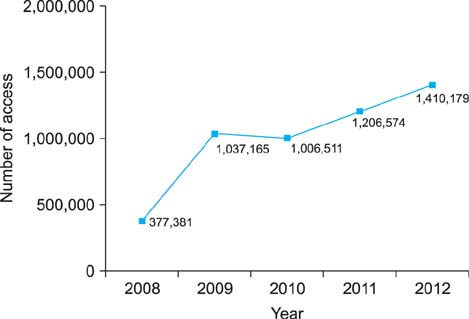Healthc Inform Res.
2013 Dec;19(4):314-323. 10.4258/hir.2013.19.4.314.
Web-Based Integrated Public Healthcare Information System of Korea: Development and Performance
- Affiliations
-
- 1Department of Health Policy and Healthcare Management, Inje Institute of Advanced Studies, Seoul, Korea. seewon@inje.ac.kr
- 2Department of Emergency and Medical Services, Sunmoon University, Asan, Korea.
- 3Department of Healthcare Management, Cheongju University, Cheongju, Korea.
- 4Korea Health and Welfare Information Service, Seoul, Korea.
- KMID: 2229508
- DOI: http://doi.org/10.4258/hir.2013.19.4.314
Abstract
OBJECTIVES
The Web-based integrated public healthcare information system (PHIS) of Korea was planned and developed from 2005 to 2010, and it is being used in 3,501 regional health organizations. This paper introduces and discusses development and performance of the system.
METHODS
We reviewed and examined documents about the development process and performance of the newly integrated PHIS. The resources we analyzed the national plan for public healthcare, information strategy for PHIS, usage and performance reports of the system.
RESULTS
The integrated PHIS included 19 functional business areas, 47 detailed health programs, and 48 inter-organizational tasks. The new PHIS improved the efficiency and effectiveness of the business process and inter-organizational business, and enhanced user satisfaction. Economic benefits were obtained from five categories: labor, health education and monitoring, clinical information management, administration and civil service, and system maintenance. The system was certified by a patent from the Korean Intellectual Property Office and accredited as an ISO 9001. It was also reviewed and received preliminary comments about its originality, advancement, and business applicability from the Patent Cooperation Treaty. It has been found to enhance the quality of policy decision-making about regional healthcare at the self-governing local government level.
CONCLUSIONS
PHIS, a Web-based integrated system, has contributed to the improvement of regional healthcare services of Korea. However, when it comes to an appropriate evolution, the needs and changing environments of community-level healthcare service and IT infrastructure should be analyzed properly in advance.
MeSH Terms
Figure
Cited by 1 articles
-
Going Abroad of Korean Health Information Systems
Young Moon Chae
Healthc Inform Res. 2014;20(3):161-162. doi: 10.4258/hir.2014.20.3.161.
Reference
-
1. Statistics Korea. Population Projections by Province: 2010-2040. Daejeon, Korea: Statistics Korea;2012.2. Organisation for Economic Co-operation and Development. OECD health data 2012: how does Korea compare [Internet]. Paris, France: OECD;2012. cited at 2012 Nov 20. Available from: http://www.oecd.org/korea/BriefingNoteKOREA2012inKorean.pdf.3. National Health Insurance Corporation. 2011 major statistics about health insurance. Seoul, Korea: National Health Insurance Corporation;2012.4. Kim JW. Alternatives to adopt smart public healthcare service. IT Policy Res. 2011; 7:1–29.5. Ryu SW, Chang YS, Lee SY, Rhee HS, Yoon KI, Lee WJ, et al. Improving strategy of regional healthcare information system in Korea. Seoul, Korea: Korea Institute for Health and Social Affairs;2006.6. Ministry of Health and Welfare. Information strategy planning for public health. Seoul, Korea: Ministry of Health and Welfare;2005.7. AbouZahr C, Boerma T. Health information systems: the foundations of public health. Bull World Health Organ. 2005; 83(8):578–583.8. Ministry of Health and Welfare. 2006 report on information of public health. Seoul, Korea: Ministry of Health and Welfare;2006.9. Ministry of Health and Welfare. 2007 report on information of public health. Seoul, Korea: Ministry of Health and Welfare;2007.10. Ministry of Health and Welfare. 2008 report on information of public health. Seoul, Korea: Ministry of Health and Welfare;2008.11. DeLone WH, McLean ER. The DeLone and McLean model of information systems success: a ten-year update. J of Manag Inf Syst. 2003; 19(4):9–30.
Article12. Maenpaa T, Suominen T, Asikainen P, Maass M, Rostila I. The outcomes of regional healthcare information systems in health care: a review of the research literature. Int J Med Inform. 2009; 78(11):757–771.
Article13. Korea Health and Welfare Information Service. Statistics on healthcare information service. Seoul, Korea: Korea Health and Welfare Information Service;2012.14. Park JH, Kim GM. A survey research on status of healthcare informatization. Seoul, Korea: Korea Health Promotion Foundation;2010.15. Ko IS, Chang H. Development of extended technology acceptance model on the intention of using PHR. J Korean Soc Health Inf Health Stat. 2013; 38(1):26–38.16. Choi W, Rho MJ, Park J, Kim KJ, Kwon YD, Choi IY. Information system success model for customer relationship management system in health promotion centers. Healthc Inform Res. 2013; 19(2):110–120.
Article17. Korea Health and Welfare Information Service. Report on SR status of 2012. Seoul, Korea: Korea Health and Welfare Information Service;2012.18. Ministry of Health and Welfare. 2012 national information plan for implementation. Seoul, Korea: Ministry of Health and Welfare;2012.
- Full Text Links
- Actions
-
Cited
- CITED
-
- Close
- Share
- Similar articles
-
- Development of Integrated ECG Management System based Web with CORBA
- Design of Wired/Wireless Integrated Medical Information Management System Based on Web Service
- Development of an Integrated Information System for the Management of Behcet's Disease
- Development of a Integrated Healthcare Information System in Standardized Environment
- Development of a Personal Health Record System Based on USB Flash Drive and Web Service





